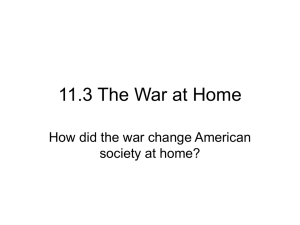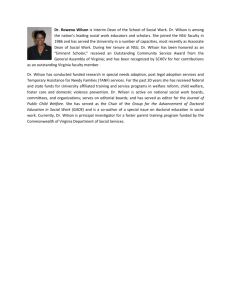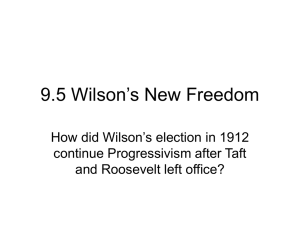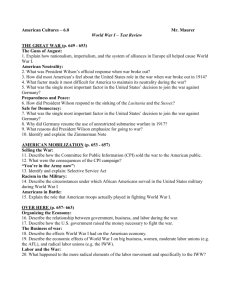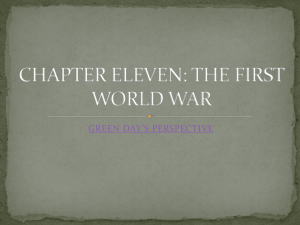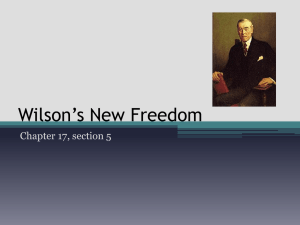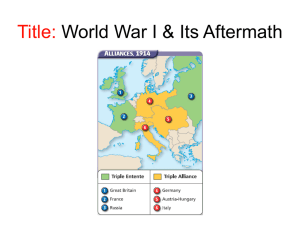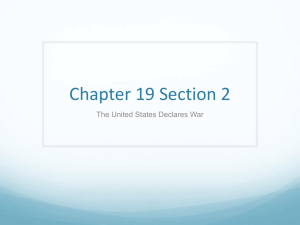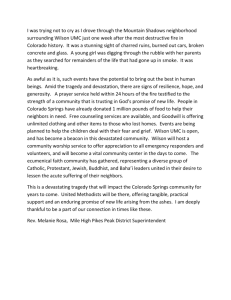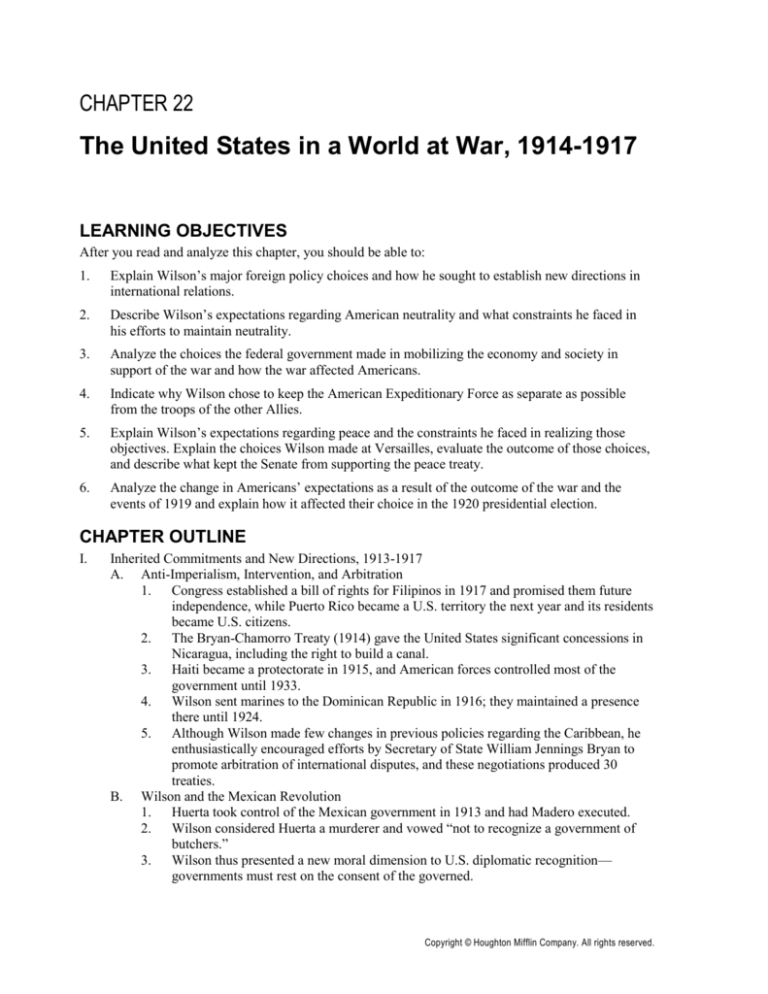
CHAPTER 22
The United States in a World at War, 1914-1917
LEARNING OBJECTIVES
After you read and analyze this chapter, you should be able to:
1.
Explain Wilson’s major foreign policy choices and how he sought to establish new directions in
international relations.
2.
Describe Wilson’s expectations regarding American neutrality and what constraints he faced in
his efforts to maintain neutrality.
3.
Analyze the choices the federal government made in mobilizing the economy and society in
support of the war and how the war affected Americans.
4.
Indicate why Wilson chose to keep the American Expeditionary Force as separate as possible
from the troops of the other Allies.
5.
Explain Wilson’s expectations regarding peace and the constraints he faced in realizing those
objectives. Explain the choices Wilson made at Versailles, evaluate the outcome of those choices,
and describe what kept the Senate from supporting the peace treaty.
6.
Analyze the change in Americans’ expectations as a result of the outcome of the war and the
events of 1919 and explain how it affected their choice in the 1920 presidential election.
CHAPTER OUTLINE
I.
Inherited Commitments and New Directions, 1913-1917
A. Anti-Imperialism, Intervention, and Arbitration
1. Congress established a bill of rights for Filipinos in 1917 and promised them future
independence, while Puerto Rico became a U.S. territory the next year and its residents
became U.S. citizens.
2. The Bryan-Chamorro Treaty (1914) gave the United States significant concessions in
Nicaragua, including the right to build a canal.
3. Haiti became a protectorate in 1915, and American forces controlled most of the
government until 1933.
4. Wilson sent marines to the Dominican Republic in 1916; they maintained a presence
there until 1924.
5. Although Wilson made few changes in previous policies regarding the Caribbean, he
enthusiastically encouraged efforts by Secretary of State William Jennings Bryan to
promote arbitration of international disputes, and these negotiations produced 30
treaties.
B. Wilson and the Mexican Revolution
1. Huerta took control of the Mexican government in 1913 and had Madero executed.
2. Wilson considered Huerta a murderer and vowed “not to recognize a government of
butchers.”
3. Wilson thus presented a new moral dimension to U.S. diplomatic recognition—
governments must rest on the consent of the governed.
Copyright © Houghton Mifflin Company. All rights reserved.
Chapter 22: The United States in a World at War, 1914-1917
4.
II.
273
Wilson found an excuse to intervene in April 1914 in Veracruz, the leading Mexican
port, after American soldiers were arrested in Tampico.
5. Huerta fled Mexico in mid-July, and Wilson withdrew the last American forces from
Veracruz in November 1914.
6. Carranza succeeded Huerta as president, and Wilson officially recognized his
government.
7. Pancho Villa, another rebel leader, decided that his best hope to take power from
Carranza was to incite war between the U.S. and Mexican governments. He led a raid
across the border and killed Americans in Columbus, New Mexico, in 1916.
a) Wilson sent a punitive expedition, led by John J. Pershing, into Mexico to capture
Villa. It was unsuccessful, and the troops withdrew from Mexico as the United
States was drawn into World War I.
The United States in a World at War, 1914-1917
A. The Great War in Europe
1. Since 1871, competition for world markets and colonies encouraged nations to
accumulate arms and seek allies.
2. The Triple Entente linked Britain, France, and Russia, while the Triple Alliance linked
Germany, Austria-Hungary, and Italy.
3. The assassination of Archduke Ferdinand at Sarajevo occurred in the midst of an arms
race between rival alliances and rising nationalist tensions.
B. American Neutrality
1. Wilson announced that the United States was not committed to either side and was to
be accorded all neutral rights, but his hopes for peace proved unrealistic.
a) Most warring nations wanted additional territory, and only a decisive victory
could deliver such a prize.
C. Neutral Rights and German U-Boats
1. Secretary of State Bryan proved willing to sacrifice neutral rights if insistence on those
rights posed the prospect of conflict with one of the belligerents, while Wilson stood
firm on maintaining all traditional rights of neutral nations, a posture that proved more
favorable to the Allies.
2. Britain began to define neutral rights by announcing a blockade not only of German
ports but also of neutral ports from which goods could reach German markets.
a) Germany responded by declaring a blockade of the British Isles, to be enforced
by its submarines, called U-boats.
3. Wilson warned that the United States would do whatever was necessary to “safeguard
American lives” and maintain their neutral rights to travel on the high seas.
a) When a German U-boat torpedoed the Lusitania, Wilson eventually issued an
ultimatum to the Germans; Bryan resigned in protest, since he thought this would
lead to war.
4. Robert Lansing, Bryan’s successor, was outspoken in favor of the Allies and urged a
show of strength. When the Germans sank the Sussex the next year, the United States
threatened to sever diplomatic relations.
a) The German response was the Sussex pledge, promising no more unannounced
U-boat attacks.
5. U.S. economic ties to the Allies grew as the war progressed, but even more significant
was the nation’s transformation from a debtor to a creditor nation.
6. In 1916, Wilson sent his adviser, Edward M. House, to Europe to explore the
possibilities of peace, and he concluded that neither side wanted a negotiated end to the
war.
7. Congress passed the National Defense Act, which more than doubled the army and
appropriated the largest naval expenditures in the country’s peacetime history.
Copyright © Houghton Mifflin Company. All rights reserved.
274
Chapter 22: The United States in a World at War, 1914-1917
D.
The Election of 1916
1. Republican Charles Evans Hughes failed to present a compelling alternative to Wilson,
so Wilson won reelection.
E. The Decision for War
1. On March 1, 1917, Wilson released the Zimmerman telegram, in which Germany
proposed that, if the United States went to war with Germany, Mexico should ally
itself with Germany and attack the United States. As a reward, Mexico could recover
Texas, New Mexico, and Arizona.
2. This outraged Americans and lent support to Wilson’s proposal to arm American
merchant ships.
3. German U-boats sank six American ships between February 3 and March 21, but
Wilson did not retreat and asked Congress for a declaration of war on April 2, 1917.
III. The Home Front
A. Mobilizing the Economy
1. Shortages of military supplies, railway transportation snarls, and serious delays in
deliveries led to increased federal direction over manufacturing, food and fuel
production, and transportation.
2. The War Industries Board (WIB) was established in 1917 to oversee production of war
materials, and its prompting increased industrial production by 20 percent.
3. The National War Labor Board, created to mediate labor disputes, endorsed collective
bargaining and gave some support for an eight-hour workday in return for a no-strike
pledge from labor.
4. One crucial American contribution to the Allied victory was food, since World War I
had severely disrupted much of European agriculture.
B. Mobilizing Public Opinion
1. Not all Americans fully supported the war, so Wilson created the Committee on Public
Information (CPI) to mobilize public opinion in support of the war.
C. Civil Liberties in Time of War
1. German Americans suffered the most from wartime hysteria, while pacifists, socialists,
and other radicals also became targets for repression.
2. Congress passed the Espionage and Sedition Acts, which prohibited interference with
the draft; outlawed criticism of the government, the armed forces, and the war effort;
and specified large fines and long prison terms for violators.
D. Changes in the Workplace
1. American labor’s wartime experience was characterized by intense activism and
remarkable productivity as well as increased opportunities for women.
E. The Great Migration and White Reactions
1. Until World War I, 90 percent of African Americans lived in the South and 75 percent
lived in rural areas.
2. By 1920, perhaps as many as 500,000 had moved north during the Great Migration,
with the largest proportional increases in the mid-western industrial cities.
3. Reasons for the Great Migration included lynchings, economic disaster, and a sharp
decline in European immigration due to the war.
a) In addition, the war heightened racial tensions in the South because some whites
resented the new options available to blacks. Several wartime racial conflicts also
erupted in northern cities as a result of the Great Migration.
IV. Americans “Over There”
A. Mobilizing for Battle
1. Almost immediately, the navy was able to strike back successfully at the German fleet,
but the army was not ready for action until April 1917.
Copyright © Houghton Mifflin Company. All rights reserved.
Chapter 22: The United States in a World at War, 1914-1917
2.
275
Many men volunteered, but not enough, so Congress rushed into law the Selective
Service Act in May 1917.
3. No women were drafted, but some chose to serve in the military, and nearly 400,000
African Americans served in a segregated army.
B. “Over There”
1. Wilson wished to make the U.S. contribution to victory as prominent as possible in
order to maximize American influence in peacemaking.
2. American losses included 115,000 casualties, including 48,000 killed in action.
V. Wilson and the Peace Conference
A. Bolshevism, the Secret Treaties, and the Fourteen Points
1. In March 1917, war-weary, hungry Russians overthrew their czar, and the Bolsheviks
seized power.
2. Lenin, the Bolshevik leader, immediately began peace negotiations.
3. Wilson spoke to Congress in January 1918 about his war aims, known as the Fourteen
Points, which emphasized lasting peace and a League of Nations.
a) The major allies reluctantly accepted Wilson’s Fourteen Points as a basis for
discussion but expressed little enthusiasm for them.
B. The World in 1919
1. Delegates to the peace conference assembled amid far-reaching change.
2. Civil war raged in Russia.
C. Wilson at Versailles
1. The Big Four—Wilson, David Lloyd George of Britain, Georges Clemenceau of
France, and Vittorio Orlando of Italy—made some major decisions.
2. Terms of peace were to be imposed, not negotiated, and Wilson learned at the outset
that the European leaders were more interested in pursuing their own national interests
than in implementing his Fourteen Points.
a) Wilson did secure the creation of a League of Nations, but the War Guilt clause
forced Germany to accept the blame for starting the war.
D. The Senate and the Treaty
1. The Senate, controlled by Republicans since the 1918 election, had to approve any
treaty, and Wilson had failed to include any prominent Republicans in his delegation to
Versailles.
2. Faced with the treaty, the Senate split into three groups—the reservationists, the
irreconcilables, and those who supported the president.
3. Wilson decided to take his case directly to the people but suffered a serious stroke and
still refused to compromise with the Senate.
4. The Senate’s defeat of the treaty meant that the United States would not join the
League of Nations.
E. Legacies of the Great War
1. The “war to end all war” spun off several wars in its wake; in the end, the war and its
peace conference left many problems unresolved.
2. Above all, the war and the resulting treaty helped to produce economic and political
instability in much of Europe, making it a breeding ground for totalitarian and
nationalistic movements that were eventually to bring another world war.
VI. America in the Aftermath of War, November 1918–November 1920
A. 1919: HCL and Strikes
1. Inflation, described in newspapers as HCL for “high cost of living,” was the most
pressing problem Americans faced after the war, and such inflation contributed to labor
unrest.
2. Unions made wage demands to maintain wartime gains and keep up with the soaring
cost of living, but management was ready for a fight.
Copyright © Houghton Mifflin Company. All rights reserved.
276
Chapter 22: The United States in a World at War, 1914-1917
a)
B.
C.
D.
E.
The largest and most dramatic labor conflict in 1919 was against U.S. Steel
Corporation.
1919: Red Scare
1. The Red Scare, led by Attorney General A. Mitchell Palmer, frightened Americans into
believing the Bolsheviks were going to take over the nation, and thousands of radicals
were arrested.
Race Riots and Lynching
1. The racial tensions of the war years continued into the postwar period, and mobs in
southern states lynched returning black soldiers while they were still in uniform.
a) Rioting also struck outside the South, and the Ku Klux Klan became powerful
again.
Amending the Constitution: Prohibition and Woman Suffrage
1. Prohibition
a) Spearheaded by the Anti-Saloon League, prohibition advocates gained strength
throughout the Progressive era.
2. Woman Suffrage
a) The states ratified the Nineteenth Amendment in August 1920.
b) Though many women by then already exercised the franchise, especially in
western states, ratification meant that the electorate for the 1920s elections was
significantly expanded.
The Election of 1920
1. The Republicans confidently expected to regain the White House in the 1920 election,
and the reaction against Wilson almost guaranteed election of any competent
Republican nominee.
2. Warren G. Harding won a Republican landslide with 37 of 48 states and 60 percent of
the popular vote—the largest popular majority up to that time.
IDENTIFICATIONS
Identify the following items and explain the significance of each. While you should include any
relevant historical terms, using your own words to write these definitions will help you better remember
these items for your next exam.
1.
Alvin York
2.
Woodrow Wilson
3.
Bryan-Chamorro Treaty
4.
Porfirio Díaz
5.
Mexican Revolution
6.
Victoriano Huerta
7.
Venustiana Carranza
8.
Veracruz
9.
Francisco “Pancho” Villa
10. nationalism
11. Balkan Peninsula
12. Slavic
13. universal military service
Copyright © Houghton Mifflin Company. All rights reserved.
Chapter 22: The United States in a World at War, 1914-1917
14. Triple Entente
15. Triple Alliance
16. Central Powers
17. western front
18. no man’s land
19. neutral
20. Hun
21. belligerent
22. contraband
23. U-boat
24. Lusitania
25. Sussex pledge
26. creditor nation
27. disarmament
28. left-wing
29. election of 1916
30. mobilization
31. Arthur Zimmermann
32. War Industries Board
33. daylight savings time
34. National War Labor Board
35. collective bargaining
36. Herbert Hoover
37. Liberty Loan
38. Creel Committee
39. vigilante
40. Espionage Act
41. Sedition Act
42. Great Migration
43. boll weevil
44. Harlem
45. Selective Service Act
46. conscientious objector
47. Jim Crow
48. American Expeditionary Force
Copyright © Houghton Mifflin Company. All rights reserved.
277
278
Chapter 22: The United States in a World at War, 1914-1917
49. salient
50. influenza
51. Croix de Guerre
52. tsar
53. Bolsheviks
54. Vladimir Lenin
55. Treaty of Brest-Litovsk
56. Fourteen Points
57. abdicate
58. Red army
59. self-determination
60. reparations
61. League of Nations
62. Treaty of Versailles
63. mandate
64. League Covenant
65. Henry Cabot Lodge
66. subversion
67. J. Edgar Hoover
68. Palmer raids
69. deportation
70. criminal syndicalism laws
71. Red Scare
72. IWW
73. Sacco and Vanzetti
74. election of 1920
MULTIPLE-CHOICE QUESTIONS
Select the correct answer.
1.
2.
The Democratic Party’s traditional opposition to imperialism
a.
was consistently defended by the Wilson administration.
b. explains their position that Puerto Rico should obtain its independence.
c.
was disregarded when the Wilson administration repeatedly intervened in the Caribbean.
d. kept the United States out of World War I until 1917.
Woodrow Wilson’s most dramatic action toward Mexico was
a.
the freezing of Mexican assets in the United States.
b. the detention of Mexican diplomats in Washington.
Copyright © Houghton Mifflin Company. All rights reserved.
Chapter 22: The United States in a World at War, 1914-1917
c.
the bombardment of Mexico City.
d. occupation of the port city of Veracruz.
3. Sentiment for entering World War I on England’s side rose as a result of
a.
Irish American views.
b. unfair German economic competition.
c.
the activity of German spies inside the United States.
d. U-boat activity.
4. Woodrow Wilson sought to keep the United States neutral when World War I began, but
a.
Secretary of State William Jennings Bryan convinced him of the necessity of war.
b. he adopted policies that favored England over Germany.
c.
the Republican Party pressured him into going to war.
d. labor unions favored war because of the jobs it would create.
5. The effects of the war on African Americans included
a.
a reduction in their standard of living.
b. their migration out of the South.
c.
the end of segregation laws and practices.
d. appointments for the first time to the cabinet and the Supreme Court.
6. Wilson moved away from neutrality
a.
because of the brilliance of British diplomacy.
b. thanks to the influence of bankers and financiers.
c.
when Germany decided to resume unrestricted submarine action.
d. when Germany invaded Belgium.
7. Woodrow Wilson won reelection in 1916
a.
even though socialists and women voted against him.
b. in part, because his opponent did not present a clear alternative.
c.
because the Republican nominee for president demanded immediate war with Germany.
d. All of these
8. The United States organized for war by
a.
demanding that Germany surrender unconditionally.
b. drafting women for noncombat military service.
c.
relying on government coordination of industry.
d. suspending the writ of habeas corpus.
9. Domestic opponents of American involvement in the war
a.
did not include the socialists.
b. won the congressional elections of 1918.
c.
negotiated secretly on their own with England in hopes of ending the war.
d. risked prosecution under the Sedition Act of 1918.
10. The war affected the condition of women because
a.
the army appointed them to command positions.
b. job opportunities increased.
c.
the marriage rate fell precipitously.
d. All of these
11. Labor unions during World War I
a.
won seats on the boards of directors of many major corporations.
b. declined in membership because of the Sedition Act.
c.
enjoyed government recognition of collective bargaining.
d. banned women from their membership.
Copyright © Houghton Mifflin Company. All rights reserved.
279
280
Chapter 22: The United States in a World at War, 1914-1917
12. The Bolsheviks
a.
seized power in Russia late in 1917.
b. supported Woodrow Wilson’s view that Germany must surrender unconditionally.
c.
continued to support the Allies.
d. insisted upon continuing the war even after the Armistice.
13. In the peace negotiations ending the war, Wilson sought and obtained
a.
an international organization to prevent wars in the future and to take action against
aggression.
b. punishment of Germany.
c.
reparations for all the damage done to American shipping by German submarines.
d. acquisition of new colonies by the United States.
14. Senators who opposed and ultimately rejected the Treaty of Versailles did so because
a.
they hoped to defeat Wilson’s try for a third presidential term.
b. they hoped to win votes among German Americans.
c.
they wanted greater involvement in European affairs.
d. of Article 10.
15. An unusually large number of strikes occurred in 1919 because
a.
Bolshevik organizers had infiltrated labor unions.
b. the AFL had used its support of the Versailles treaty to win the support of the president.
c.
wages had not kept up with the cost of living.
d. public support for unions was at a peak.
ESSAY QUESTIONS
1.
When war broke out in Europe, the United States tried at first to remain neutral, but found that
both England and Germany violated traditional rules of neutrality. In the end, however, America
decided to go to war against Germany. Why?
DEVELOPING YOUR ANSWER: Although England violated traditional neutrality rights on the
high seas, Germany did worse with its U-boat attacks: it caused loss of life. When writing about
Germany’s actions against neutral shipping on the high seas, include references to the sinking of
the Lusitania, the Sussex Pledge, and Germany’s resumption of unrestricted submarine warfare on
February 1, 1917.
Other factors that drew many Americans closer to Britain than to Germany were their common
language and culture, good relations since the mid-1890s, close ties between their upper classes,
and many close business ties. (Germany’s attack on neutral Belgium also inclined many
Americans to the side of the Allies.)
2.
Woodrow Wilson has often been portrayed as a man of high ideals in the conduct of foreign
policy. Analyze his performance in connection with World War I in support of this
characterization.
DEVELOPING YOUR ANSWER: Before the United States became involved in the war, Wilson
hoped to be the peacemaker who put out the fires in Europe. His policy of neutrality toward both
sides was a step in that direction. In addition to staying out of the conflict, he tried early in 1916 to
get Britain and Germany to consider peace by sending an envoy to talk to both.
Even before the United States entered the war, Wilson envisioned an international organization
for peace in the world. This ideal remained one of his greatest goals after the country went to war.
Be sure to trace its inclusion in the Fourteen Points and its realization as the League of Nations in
the Treaty of Versailles thanks to Wilson’s efforts.
Copyright © Houghton Mifflin Company. All rights reserved.
Chapter 22: The United States in a World at War, 1914-1917
281
It is perhaps, above all, Wilson’s Fourteen Points that reveal his idealism. These should be
discussed to provide evidence of his belief in high-mindedness in foreign affairs.
3.
Discuss the effects of World War I on American women and on African Americans.
DEVELOPING YOUR ANSWER: For women, the war brought new work opportunities. Explain
why women found jobs in factories, offices, and retail establishments in greater numbers than ever
before. Women, in addition, served in the U.S. Navy and Marines, though not in the U.S. Army.
The changes in women’s expectations regarding their own personal freedom should also be
explored.
For African Americans, the developments that you should explore, along with the reasons behind
them, include the large-scale movement out of the South to the North and Midwest during the
war; the increase in racial tension in the South; the violence that blacks encountered in northern
and mid-western cities; and the position of the African American fighting man in the military.
Following the war’s end, African Americans encountered a considerable amount of violence, as
race riots and lynching flared in both North and South.
4.
As the United States entered World War I, Woodrow Wilson proclaimed that, “The world must be
made safe for democracy.” To what extent did the United States, itself, live up to this ideal both
during and immediately after the conflict?
DEVELOPING YOUR ANSWER: The picture here is not a flattering one. Themes for
exploration during the war, itself, include the following:
The treatment accorded African Americans in the military, as well as in the North and the
South (see question 3)
Prosecution of dissenters under the Sedition Act
Persecution of German Americans
The suppression of the International Workers of the World
Undemocratic activities continued after the war, as well. You should therefore also include
the following in your presentation:
The effort by business and political leaders to undermine labor unions
The Red Scare, with special attention to the Palmer Raids, and their implications for a
democratic society
And again, riots against and lynching of African Americans
MAP EXERCISES
1.
How did the United States change internally under the impact of the war? Which regions and
states were the most affected? See the chapter’s opening map for possible answers.
2.
Did the changes in Europe that resulted from the war serve to increase or decrease ethnic and
nationalist tensions? Examine Map 22.3 to formulate an answer.
INDIVIDUAL CHOICES
Alvin York
To answer the following questions, consult the Individual Choices section at the beginning of the
chapter.
Copyright © Houghton Mifflin Company. All rights reserved.
282
Chapter 22: The United States in a World at War, 1914-1917
1.
Briefly describe Alvin York’s background.
2.
What changed in 1915?
3.
How did York reconcile his role as a soldier with his religious beliefs?
4.
Would you consider York a hero? Why or why not?
5.
If you had been in York’s place, would you have had the same regrets at the end of your life?
Why or why not?
INDIVIDUAL VOICES
Examining a Primary Source: Woodrow Wilson Proposes His
Fourteen Points
To answer the following questions, consult the Individual Voices section at the end of the chapter.
1.
To what event(s) does this passage refer? To whom is it dictated?
2.
How do these statements compare with the outcome of the peace conference?
3.
What are the connections between Points I through V, the causes of the war in general, and the
reasons for America’s entrance into the war in particular?
4.
Was Wilson creating unrealistic expectations with statements such as these?
5.
Compare Wilson’s reasons, as stated here, for committing America to war with Alvin York’s
reasons, as he understood them, for his going to war.
RUBRIC: Prepare a chart of war aims and the actual results of the war. Were the major countries
involved satisfied with the results? Why or why not?
MAJOR WWI
PARTICIPANTS
WAR AIMS
WAR RESULTS
SUCCESS OF COUNTRY IN
ACHIEVING ITS GOALS
ANSWERS TO MULTIPLE-CHOICE QUESTIONS
1.
c.
Examples of intervention include Haiti and the Dominican Republic. See page 680.
a.
While president, Wilson repeatedly intervened in Central American and Caribbean nations.
See page 680.
b.
In 1917, they enacted legislation making Puerto Rico a U.S. territory. See page 680.
d. Wilson kept the nation out of the war because he hoped the United States could play the part
of peacemaker. See page 684.
Copyright © Houghton Mifflin Company. All rights reserved.
Chapter 22: The United States in a World at War, 1914-1917
2.
283
d.
Following the arrest of several American sailors, he had the navy occupy Veracruz for
more than half a year. See pages 680-683.
a.
He did not do so. See pages 680-683.
b.
Wilson did not do this. See pages 680-683.
c.
Although Wilson on two occasions took military action against Mexico, the capital city was
not attacked. See pages 680-683.
3.
d.
German submarine assaults on neutral shipping turned U.S. public opinion against
Germany; the attack on the British passenger ship Lusitania resulted in the loss of American lives.
See page 687.
a.
Irish Americans despised the English. See page 686-688.
b.
There is no evidence for this. See page 686-688.
c.
There is no evidence that this turned American public opinion favorably toward England.
See page 686-688.
4.
b.
He did not protest too strongly against British violations of American neutrality on the high
seas. See pages 686-688.
a.
Bryan was even more adamant than Wilson that the United States remain neutral and was
even willing to sacrifice the traditional rights of neutrals to that end. After the sinking of the
Lusitania, he resigned rather than be part of a strong diplomatic protest against Germany that he
thought might lead to war. See page 687.
c.
During the presidential campaign of 1916, for example, the Republican candidate tried to
avoid taking a position on what America should do. He also sought to win the support of German
Americans. See page 688.
d.
5.
6.
b.
There is no evidence that would support this view.
See pages 693-694.
a.
Many found employment in industry at higher pay. See pages 693-694.
c.
In fact, hostility to African Americans increased. See pages 693-694.
d.
See pages 693-694.
c.
This led Wilson to immediately sever diplomatic ties with Germany. See page 689.
a.
There is no evidence for this. See page 689.
b.
There is no evidence to support this statement. See page 689.
d. This occurred at the beginning of the war. Wilson did not move away from neutrality until
much later. See pages 683-684.
7.
8.
b.
He refused to take a clearly defined stand on issues related to the war. See page 688.
a.
They supported his reelection. See page 688.
c.
He avoided taking a stand on what America should do about the war. See page 688.
d.
Only b is correct. See page 688.
c.
The federal government asserted direct control over the economy in order to organize for
war. See page 690.
a.
Wilson, for example, made no such demand in his war message to Congress. See page 690.
Copyright © Houghton Mifflin Company. All rights reserved.
284
Chapter 22: The United States in a World at War, 1914-1917
b.
Although women served in the military, they were not drafted. See pages 692-693.
d. Habeas corpus was not suspended, although other civil rights were constrained. See page
692.
9.
d.
There were, in fact, many arrests under it. See pages 691-693.
a.
Socialists opposed the war. See pages 690-691.
b.
But for those who were opposed to the war, see page 692.
c.
There is no evidence of any such activity by opponents of the war.
10. b.
More women now worked outside the home. See pages 692-693.
a.
For their limited military role, see pages 692-693.
c.
There is no evidence for this.
d.
Only 10b is correct.
11. c.
The National War Labor Board permitted collective bargaining by unions. See pages 690691.
a.
Labor’s gains during the war did not include this. See pages 690-691.
b.
Union membership grew markedly during the war. See pages 690-691.
d.
There is no evidence that this occurred. See pages 690-691.
12. a.
See page 698.
b. Wilson never called for unconditional surrender, neither in his war message to Congress in
1917, nor in his Fourteen Points speech to Congress in 1918. See pages 686 and 708.
c.
In fact, they embarrassed the Allies by publishing secret treaties. See page 700.
d.
Russia concluded peace with Germany prior to the Armistice. See page 698.
13. a.
The League of Nations was the result. See pages 697-700.
b. France and England sought harsh treatment of Germany, including heavy war reparations.
Wilson did not. See pages 699-701.
c.
See pages 699-701.
d.
See pages 699-701.
14. d.
The reservationists opposed the treaty because Congress could use Article 10 to commit
U.S. troops to war without approval. See page 702.
a.
There is no evidence whatsoever that Wilson hoped to run again. See page 707.
b.
Such domestic political considerations did not play a role. See page 707.
c.
The Senate’s irreconcilables opposed any such involvement. See page 707.
Copyright © Houghton Mifflin Company. All rights reserved.
Chapter 22: The United States in a World at War, 1914-1917
15. c.
285
The cost of living had doubled since 1913. This inflation led to labor unrest. See page 704.
a.
Although industrialists and politicians asserted that the labor problems were caused by
Bolshevik influence, there is no evidence that Bolsheviks (Communists, radicals, “Reds”) had
infiltrated the unions. See page 704.
b. There is no evidence that the AFL, which began a drive in 1919 to enroll new members in
the steel industry, supported the treaty. See pages 704.
d. Many people, in fact, were determined in 1919 to resist the unions and to force them to
reverse the gains they had made during the war. See page 704.
Copyright © Houghton Mifflin Company. All rights reserved.

